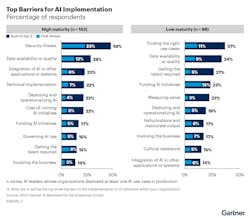Companies with High AI Maturity Keep Projects Operational for 3 Years
For companies that are considered mature in their AI implementation, 45% said their AI initiatives remain in production for three years or more to ensure sustained impact and value. This is according to a recent survey from Gartner, Inc. This compares to only 20% in low-maturity organizations.
The survey revealed that choosing AI projects based on business value and technical feasibility, along with establishing robust governance structures and engineering practices, ensures the longevity of AI projects in high-maturity organizations.
“Trust is one of the differentiators between success and failure for an AI or GenAI initiative,” said Birgi Tamersoy, senior director analyst at Gartner.
The survey found that in 57% of high-maturity organizations, business units trust and are ready to use new AI solutions compared with only 14% of low-maturity organizations. “Building trust in AI and GenAI solutions fundamentally drives adoption, and since adoption is the first step in generating value, it significantly influences success,” said Tamersoy.
Data Availability and Quality Challenge AI Implementation
Regardless of AI maturity, data availability and quality are among the top challenges in AI implementation, as identified by 34% of leaders from low-maturity and 29% from high-maturity organizations, respectively.
For high-maturity organizations, 48% of leaders identified security threats as one of their top three implementation barriers, while 37% of leaders in low-maturity organizations said finding the right use case was a top barrier.
Implement Metrics for Optimal AI Results
The survey also revealed that creating metrics contributes to AI efficacy. High-maturity organizations can deliver high-level impacts on their AI projects over time because they regularly quantify the benefits of their AI initiatives and evaluate the success through multiple metrics. The survey found that 63% of leaders from high-maturity organizations run financial analysis on risk factors, conduct ROI analysis and concretely measure customer impact, which in return help them sustain AI success.
Appoint a Dedicated AI Leader to Foster AI Innovation and Develop AI Infrastructure
Ninety-one percent of leaders from high-maturity organizations said they have already appointed dedicated AI leaders. As part of their role, AI leaders prioritize fostering AI innovation (65%), delivering AI infrastructure (56%), building AI organizations and teams (50%), and designing AI architecture (48%).
In high-maturity organizations, almost 60% of leaders said they have centralized their AI strategy, governance, data and infrastructure capabilities to increase consistency and efficiency within their organization. “This reflects a strategic approach to managing AI resources and initiatives, which requires dedicated AI teams,” said Tamersoy.

